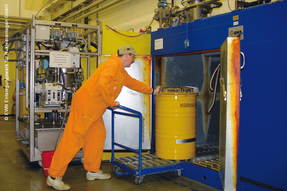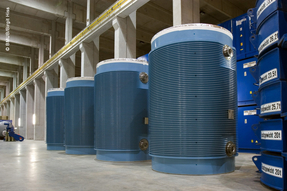Radioactive waste management
Radioactive substances that are produced during the dismantling of a nuclear plant and cannot be disposed of safely (for example through reuse in another nuclear facility) must be disposed of as radioactive waste. The same applies to the waste produced during the operation of the facility, particularly the spent fuel elements.
In terms of the total amount of material from the controlled area of a nuclear facility – approximately 200,000 tonnes for a power reactor – the volume of radioactive waste from decommissioning makes up a small percentage. Typical nuclides in nuclear reactors are relatively short-lived beta/gamma emitters, such as cobalt-60 and caesium-137. Various other radionuclides are also subject to radioactivity monitoring. In nuclear fuel cycle facilities, there are also long-lived radionuclides, which are particularly radiotoxic due to their alpha activity.
The major share of radioactive waste from decommissioning originates from nuclear power plants and nuclear fuel cycle facilities. Much smaller amounts originate from the decommissioning of research reactors and other nuclear research facilities.


Radioactive waste must be isolated from the biosphere for long periods of time. This can be achieved by disposal of the waste in a repository. Before the waste is placed in a repository, conditioning and interim storage are required. Local interim storage facilities are therefore usually set up during the decommissioning of power reactors to store low- and medium-level radioactive waste; these facilities take most of the radioactive waste from the dismantling of the facilities.
Pursuant to Section 9a (1), sentence 2 of the German Atomic Energy Act, until 30 June 2005, the spent fuel elements from power reactors, as distinct from other radioactive waste, could be sent to reprocessing plants. However, this is now prohibited. Under the current legislation, spent fuel elements – if they have not already been placed in a central interim storage facility – must be stored safely in a local facility until they are sent to a repository. The final release of the site as a whole – meaning the nuclear power plant and the local interim storage facility – from regulatory control thus depends not only the complete dismantling of the power plant but also on when the spent fuel elements can be transferred as radioactive waste from the local interim storage facility to a repository.